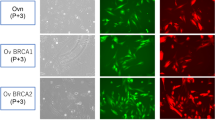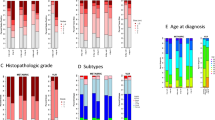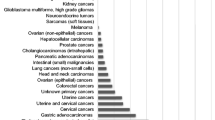Abstract
Somatic mutations in TP53 are seen in many human cancers. In addition, the protein product of the wild-type TP53 can be sequestered by the protein MDM2 (murine double minute 2). This protein is commonly overexpressed in human sarcomas and gliomas, usually as a result of gene amplification. In this study, 43 ovarian carcinomas (OCs) were analysed for aberrations in the TP53 gene by immunohistochemistry (IHC), loss of heterozygosity (LOH) or mutation analysis. The MDM2 gene and its product was studied by Southern blotting and IHC. Over 50% of the OCs studied showed mutations in TP53 by either direct sequencing (19/36, 53%), positive IHC (23,43, 53%) or both, whereas 0/32 had amplification of MDM2 and only 1/37 tumours had positive IHC using the anti-MDM2 antibody IF-2. The solitary example of positive IHC in this series was seen in a mixed müllerian tumour with sarcomatous differentiation and was not accompanied by MDM2 DNA amplification. These results support previous data showing that around 50% of OCs have mutations in TP53 and in addition, suggest that MDM2 is not amplified in OC, but the presence of sarcomatous features in mixed müllerian tumours may result in positive immunohistochemistry with IF-2.
Similar content being viewed by others
Author information
Authors and Affiliations
Rights and permissions
About this article
Cite this article
Foulkes, W., Stamp, G., Afzal, S. et al. MDM2 overexpression is rare in ovarian carcinoma irrespective of TP53 mutation status. Br J Cancer 72, 883–888 (1995). https://doi.org/10.1038/bjc.1995.428
Issue Date:
DOI: https://doi.org/10.1038/bjc.1995.428
- Springer Nature Limited
This article is cited by
-
Anoikis related genes may be novel markers associated with prognosis for ovarian cancer
Scientific Reports (2024)
-
Influence of the MDM2 single nucleotide polymorphism SNP309 on tumour development in BRCA1 mutation carriers
BMC Cancer (2006)
-
Mdm2 overexpression and p14ARF inactivation are two mutually exclusive events in primary human lung tumors
Oncogene (2002)
-
Alterations in MDM2 expression in esophageal squamous cell carcinoma: Relationship with p53 status
Pathology & Oncology Research (2001)
-
MDM2 in breast cancer
Breast Cancer (1997)




